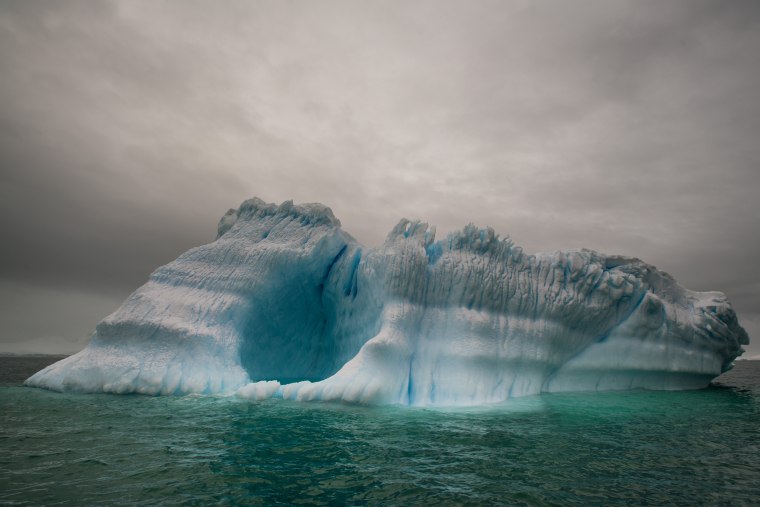From Miami to Bangalore, India, to Cape Town, South Africa, some of the world’s biggest cities are facing a shortage of drinking water.
But now an engineering firm in the Middle East is moving forward with an audacious scheme that has been discussed since at least the 1970s: tow icebergs thousands of miles from Antarctica to water-starved regions, where the ice would be brought ashore and used to produce huge amounts of fresh drinking water.
“If we succeed with this project, it could solve one of the world’s biggest problems,” says Abdulla Alshehi, founder of National Advisor Bureau, the United Arab Emirates-based firm. Alshebi said that 1.2 billion people don’t have access to clean water, and by 2050, 50 percent of the world will face water shortages.
"So if we can show this is viable," he said, "it could ultimately help not only the UAE, but all humanity.”
In November the company plans to begin a pilot study, using satellite imagery to scour the Southern Ocean for a suitable iceberg, lasso it with nets and chains, and then use a small flotilla of boats to tow it 4,000 miles or so to either Australia or South Africa — whichever is closer to the berg's original position.
If the effort succeeds, the water will be sold to a government. Then the company will attempt to tow a second iceberg on an 8,000-mile journey from the Southern Ocean to the UAE., which is facing its own severe shortage of fresh water.
Meeting the need
The $60-million effort, which will be bankrolled by private investors, could start as soon as next April with the aim of providing drinking water that could be used across the country. Ultimately, Alshehi plans to deliver a steady stream of icebergs to secure fresh water for regions where it's in chronic short supply.
“The entire world is in need of water, but initially we would be looking at countries such as India, South Africa and Saudi Arabia,” he says.
Alshehi could soon be joined by others. Experts from France, Norway and South Africa are looking to raise funds for their own mission to tow an iceberg to Cape Town, which recently averted a crisis after authorities placed severe restrictions on water use and even used public shaming to stop people from using too much water.
But before launching their own pilot study, the experts are looking to secure funding for the project and an agreement with the South African government.
A glacial pace
The icebergs Alshehi has his eyes on measure about 2,000 feet by 7,000 feet and weigh around 100 million tons. Such mammoth bergs are too big for ships alone to tow, so plans call for the vessels to seek out favorable ocean currents to speed the journey. Estimates suggest that the icebergs could be towed at a speed of roughly 1.5 miles an hour. That glacial pace means a trip to the UAE would take about 11 months.
Alshehi is tight-lipped about exactly how water from a towed iceberg would be obtained and distributed once the iceberg reaches its destination. But the general plan is to crush the iceberg bit by bit while it's still offshore, then load the ice onto tanker ships and take it to shore, where the liquid water would be purified and sold to the government and private water companies.
A significant amount of the iceberg would melt along the way. And some experts worry that icebergs might simply fall apart along the way.
“Transporting ice over these distances will be a major challenge,” says Nick Holschuh, a glaciologist at the University of Washington. “Not only do they have to deal with losses of ice due to direct melting, they have to prevent the mechanical breakup of the iceberg as surface melt accumulates. Any pre-existing weaknesses will affect the iceberg’s resilience to warm ocean water, warm air and stresses induced by towing.”
But Alshehi is undeterred. He estimates that about 30 percent of a large iceberg would melt on the trip from Antarctica to the UAE. But he says the enormous quantities of fresh water trapped within one of these large icebergs — between 100 million and 200 million cubic meters — would be enough to meet the drinking water needs of 1 million people for five years. Even if a third of the iceberg is lost, he says, it’s still enough to justify the effort and enormous cost.
Environmental concerns?
What about the environmental cost of towing icebergs? Alshehi says there is no reason for concern, pointing out that the bergs to be lassoed have already broken away from the Antarctic ice sheet and are floating in the ocean hundreds or thousands of miles north of the southernmost continent.
Holschuh agrees.
“Icebergs breaking away from the main Antarctic ice sheet is just a natural consequence of ice flow,” he says. “By the time they’re fully separated from the grounding ice, they have limited impact on the rest of the ice-ocean system. So for the volumes of ice we’re talking about, dragging away these icebergs would result in almost no changes.”
WANT MORE STORIES ABOUT WATER-SAVING TECHNOLOGIES?
- Can these water-gathering devices help avert 'pipeageddon?'
- How 'Cool Roofs' Can Pull the Plug on Water Shortages
- Two audacious plans for saving the world's ice sheets

